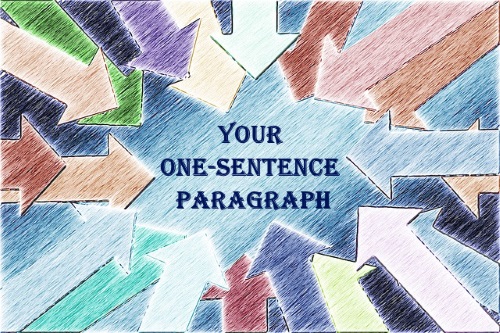The last time I baked cupcakes, I followed the directions on the box to the letter. I’m far from a celebrity chef, so following the recipe would be the only way for me to bake anything edible.
My grandmother, on the other hand, never made anything from a box. I don’t even remember her following a recipe. She always said that if you add “a little bit of everything” it would taste fine. And she was right. It always did.
Writing an essay is kind of like baking cupcakes. If you’re a novice essay writer or a novice baker, you need to follow the rules to learn how it’s done.
Once you become a more experienced writer or expert baker, you know how the words or ingredients work together. You can bend those rules a little, throw in a little of this and a little of that, and your work will be perfection (or at least pretty darn close to perfection).
While I certainly can’t tell you which baking rules to bend, I can help you out with a few essay writing rules. Keep reading to learn one rule that can’t be broken and 10 essay rules that you can throw out the window.
One Rule to Rule Them All
No matter what bloggers, grammarians, or other professors say, if your professor requires you to follow a specific essay rule, do it. (Your grade depends on it.)
For instance, if every other professor tells you that first person point of view isn’t appropriate for academic essays, but your current prof says that your essay must be written in first person, guess what?
Your job is to write in first person (if for no other reason than to make your prof happy). Not sure what your prof expects? Make sure to read your course syllabus and all assignment guidelines.
Okay, now that you know what rules you should absolutely follow, here are 10 essay writing rules you don’t always have to follow.
10 Essay Writing Rules to Throw Out the Window
These 10 essay writing rules have been drilled into our heads by English teachers for a very long time, but I’m not suggesting that you should completely abandon the rules.
I’m simply suggesting that there are times where bending the rules is okay and, in fact, can sometimes lead to more compelling writing.
Rule 1: Don’t use contractions
Avoiding contractions can bring the flavor of old-school formality to your writing, but contractions are now more common and reflect modern language usage. Thus, it’s fine to use them in your essay.
Did you notice my use of the contraction “it’s” above? It would seem a bit out of place to include such formality here by writing “it is,” wouldn’t it? (Or should I say, “would it not?” See? Contractions just work better sometimes.)
When to consider throwing this rule out the window
Most writing today uses contractions, and it’s generally acceptable to use them in just about any writing, except for the most formal of essays.
Rule 2: Don’t end with a preposition
Ending a sentence with a preposition can create an informal tone. However, if used correctly, ending a sentence in a preposition actually makes your writing flow more smoothly.
Here’s an example. If you’re assigned a group project in your class, your prof might ask, “Who do you want to work with?” Sure, this questions ends with a preposition (with), but it reflects our use of language today.
You’d only expect to hear, “With whom would you like to work?” from a headmaster at Hogwarts.
When to consider throwing this rule out the window
If you’re considering breaking this rule, simply read the sentence aloud and see how it sounds. If it sounds too informal, chances are you shouldn’t break the rule.
For instance, the question, “Where is that place at?” sounds like casual conversation, not like formal essay writing. Instead, write, “Where is the restaurant?”
Rule 3: Don’t start a sentence with “and” or “but”
Your teachers stressed that you shouldn’t begin a sentence with “and” or “but” because conjunctions such as these are more likely to result in sentence fragments.
Here’s an example:
I like cupcakes and ice cream. But not ice cream cake.
The second phrase is just that, a phrase. It’s not a complete sentence. To revise, simply combine them to read, “I like cupcakes and ice cream but not ice cream cake.”
When to consider throwing this rule out the window
If you begin a sentence with “and” or “but,” make sure you’re using it correctly and that you’ve actually written a complete sentence.
You might also consider throwing this rule out the window to create emphasis.
For example, if you’re arguing that GMOs shouldn’t be used in any boxed cake mixes, you might state, “Some people believe that GMOs are harmless. But they’re not.”
Sure, you could easily combine these two sentences, but the period creates a longer pause than a comma. It adds emphasis and makes the audience take notice of your argument.
Rule 4: Don’t use passive voice
Passive voice has been used effectively by professional writers in just about every form of writing. See? I just used passive voice, and it worked, right?
So if it’s effective, why do teachers tell you to avoid passive voice? They do so because it can create weak and generalized writing.
Take, for example, this sentence:
A riot was started when the bakery ran out of donuts.
While it may be a factual statement, this sentence written in passive voice isn’t exactly interesting, nor does it capture the drama of the situation.
When to consider throwing this rule out the window
Whether you use active or passive voice is stylistic choice. Active voice is generally preferred. But if you want to add emphasis to a point or need to write a more generalized statement, use passive voice.
Here’s an example:
Not even one donut was left in the bakery after the riot.
This sentence emphasizes the fact that not even one donut was left. In this case, passive voice is more effective. There’s no need to mention that a specific person (or people) failed to leave donuts behind.
Need a little more help understanding when to use active and passive voice? Read Passive Voice: How to Avoid this Writing Pitfall.
Rule 5: Don’t split infinitives
To split infinitives is to boldly go where no writer has gone before. Recognize the famous “to boldly go…” line from Star Trek? “To boldly go” is much more powerful than “to go boldly,” isn’t it? Why? Because it inserts “boldly” and dares to split an infinitive.
When to consider throwing the rule out the window
Whether to split infinitives is a stylistic choice, but sometimes sentences that don’t split the infinitive are actually somewhat fussy and maybe even a little more awkward than sentences that do split the infinitive.
Check out this awkward example that does not split an infinitive:
The customers were unable to understand fully why the bakery raised the price of cupcakes.
In this case, if you rearrange the sentence to split the infinitive it becomes much clearer.
The customers were unable to fully understand why the bakery raised the price of cupcakes.
Rule 6: Don’t write a one-sentence paragraph
If you’re an avid reader of online blogs, articles, and websites, you’ll see one-sentence paragraphs all the time. But what’s the point of writing this way?
A one-sentence paragraph adds emphasis.
See what I just did? I added a one-sentence paragraph to stress the fact that a one-sentence paragraph can actually be a useful strategy to draw attention.
When to consider throwing this rule out the window
If you’re in an introductory writing course, your professors may not be too happy with seeing a one-sentence paragraph. This is probably because they fear you might not understand the importance of creating well-developed paragraphs.
If, on the other hand, you’re a more advanced writer, you can usually insert a one-sentence paragraph to add emphasis to your statement.
A word of caution: Don’t get carried away. A one-sentence paragraph might work fine in an academic essay, but if you throw a bunch of them in, they lose their impact.
Rule 7: Don’t write a one-word sentence
Really? Why not? Of course, strict grammarians (and your prof just might be one of them) feel that one-word sentences go against just about every rule ever created for proper sentence development. And they’d be right.
That doesn’t mean, though, that rules can’t change. Think about how many football or hockey rules have changed in the past few decades. Think about how many laws have changed in the last year. It only makes sense that grammar rules should be updated too.
When to consider throwing this rule out the window
Formal essays have far fewer occasions to use one-word sentences than, say, blogs, emails, or advertisements, but that doesn’t mean they can’t be used.
Sentence variety is important when writing an essay, so mix longer and shorter sentences together to create reader interest.
In academic essays, you’ll likely end up with some pretty long sentences, so if you opt for the one-word sentence, it will stand out and make your readers take notice.
Rule 8: Paragraphs must be 3–5 sentences long
Back in the day, when you were learning how to construct paragraphs by using topic sentences and supporting details, your teachers told you that paragraphs needed to be three to five sentences long, so you could a write topic sentence and include supporting evidence.
Now that you’re a more seasoned writer, you can certainly move beyond this basic structure. Academic writing usually involves longer and more complex arguments, meaning you need more space to develop your ideas.
When to consider throwing this rule out the window
You can pretty much break this middle school rule any time you write an essay. Of course, that’s not to say that you can’t make a choice to include a shorter paragraph to make a specific statement. But in general, move beyond consistently short paragraphs.
Need a refresher on creating effective paragraphs? Read Anatomy of the Perfect Essay Paragraph Structure.
Rule 9: Thesis statements must appear at the end of the introduction paragraph
I’m sure you’ve been told a gazillion times: In your introductory paragraph, you need to first introduce your topic, then narrow your focus to a clear thesis statement that informs readers of the focus of your essay.
Makes sense, right? But what if you’re writing a 15-page paper? What if you need more than one introduction paragraph to fully introduce your topic?
If that’s the case, don’t feel as though you need to create one giant paragraph just so you can put your thesis at the end of it.
When to consider throwing this rule out the window
As long as you use your opening paragraphs to introduce material and readers get a sense of your focus fairly early in the paper, you can include your thesis a little later in the essay.
(Unless, of course, your prof is a stickler for a thesis statement at the end of the introduction paragraph—then it must appear after paragraph one.)
Want a quick refresher on thesis statements? Read How to Turn a Good Thesis Statement Into a Great One.
Rule 10: Essays must be 5 paragraphs long
This is yet another one of those rules that was drilled into your head long ago: every essay must have an introduction paragraph, three supporting (body) paragraphs, and a concluding paragraph.
I’m certainly not telling you to abandon the basic essay structure of introduction, body, and conclusion, but I am telling you that it’s fine to stray from the basic format of only one introduction or conclusion paragraph and only three body paragraphs.
Expand your writing to include additional body paragraphs (and maybe even a one-sentence paragraph) to create stronger arguments.
Need another reason to break this rule? Adding more paragraphs means more content and a longer paper that will actually meet word count requirements. (Just be sure to actually include relevant content, not useless fluff just to make your paper longer.)
When to consider throwing this rule out the window
As soon as you’ve mastered the 5-paragraph essay, feel free to throw the rule out the window.
This won’t be that hard because, once you start writing about more complex topics and issues—like nuclear fusion, immigration, and saving the planet—you’ll need a heckuva lot more than five paragraphs to do the topic justice.
One Final Piece of Writing Wisdom
If you’ve had a hard time getting through this post because you’re still thinking donuts and cupcakes, then by all means, take a break. Enjoy a sweet treat.
No, I’m not encouraging over-eating, and I’m not trying to increase stock prices in bakeries. I’m telling you to take a break because, of all the essay writing rules, it’s an important one that you should always follow.
I know, I know, you’ll say, “But I work the best under pressure.”
While you might think that you do your best work minutes before an assignment deadline, chances are, if you were to take a break from your draft and come back a few hours (or days) later, you’d see that a little (or maybe even a lot) of revision is in order.
You don’t, after all, want to lose points on your essay for something like not following punctuation rules after brilliantly throwing any of the above essay writing rules out the window!
If you’ve already taken your snack break and revised your draft but still feel like throwing the entire paper out the window and starting over, don’t scrap it just yet. Let the experts at Kibin offer some advice.
Happy writing!





